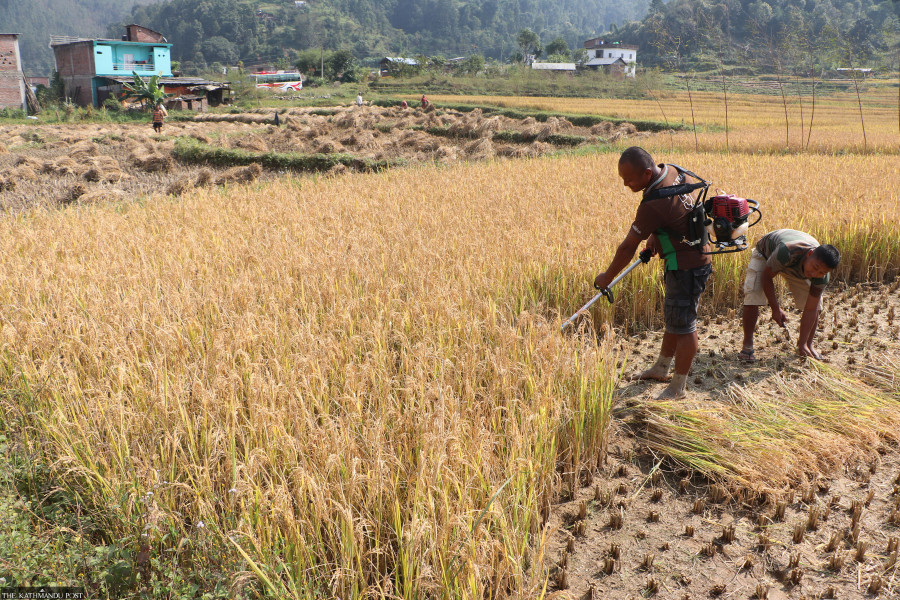Money
Lumbini is self-sufficient in food production, officials say
The province produced 2.51 million tonnes of food, resulting in a surplus of 445,000 tonnes, according to officials.
Madhav Aryal
Lumbini province has become self-sufficient in food production, the provincial Agriculture Development Directorate has announced. The province, which consists of 12 districts, grows enough food to feed its entire population and does not need to buy or import it.
According to the directorate, all 12 districts in the province achieved self-sufficiency in staple food production two years ago.
Farm output increased after farmers adopted a commercial farming system, the directorate said. There is potential to expand the acreage and improve the productivity of high-value goods.
The engagement of the private sector and cooperatives, and the role played by the three levels of government also helped to make the province self-sufficient in food production, the directorate said.
Yam Narayan Devkota, chief of the directorate, said that Rupandehi, Kapilvastu, Bardia, Dang, Banke and Nawalparasi (West) had turned into food surplus districts.
"The productivity of the land in the western Tarai districts was always high. Adopting modern farm technology has further increased it," Devkota said. “Diversification of crops has also increased the productivity level,” he said.
Although food production in the province's hill districts like Palpa, Gulmi, Arghakhanchi, Pyuthan, Rolpa, Rukum and East Rukum is not so high, they grow sufficient food to feed the population, the statistics show.
The 12 districts in the province produced a combined 2.51 million tonnes of food, resulting in a surplus of 445,000 tonnes, according to Devkota.
Despite being self-sufficient in food production, the food distribution situation is not equitable. Devkota said that 52 percent of households in the province are food insecure as their output is not enough to feed them round the year.
"Around 10 percent of households in the province are severely food insecure,” Devkota said, adding that due to the resultant nutrition deficiency, infant and child mortality rates are high in the province. Because of the unequal distribution of food, 37.6 percent of the population is malnourished.
Food availability in Bardia district is 296,000 tonnes, Rupandehi 274,000 tonnes, Dang 232,000 tonnes, Kapilvastu 226,000 tonnes and Banke 222,000 tonnes.
West Nawalparasi has 121,000 tonnes of food available for its population, Palpa 94,000 tonnes, Gulmi 114,000 tonnes, Arghakhanchi 95,000 tonnes, Rolpa 80,000 tonnes, Pyuthan 76,000 tonnes and Rukum East 35,000 tonnes.
In terms of area under food cultivation, the figure for Lumbini province is 621,900 hectares. Cash crops are produced on 99,000 hectares. Pulses are grown on 80,000 hectares, fruits on 16,000 hectares, vegetables on 41,000 hectares and spices on 8,000 hectares, the directorate said.
The growing trend of eating only rice has led to a decline in the consumption of other healthy foods, leading to massive imports of rice, said Devkota.
“The growing culture of eating rice should be discouraged. People have to diversify their food eating habits and eat other foods like maize, wheat, millet and buckwheat to reduce dependency on rice.”
Kamana Adhikari Bhattarai, senior officer at the Agriculture Knowledge Centre, Palpa, said that 42.1 percent of children in the province under the age of five were malnourished due to an imbalance in their diet.
In Lumbini province, 38.58 percent of children are stunted while 53 percent of children have anemia. Landless, Dalit, tribal and low-income families are more affected, she said.
"This is because a section of the population cannot afford to eat a balanced diet. There is no balance in the diet as well. The habit of eating rice only has increased imports of rice at an alarming level,” she said.
“If there is no consumption of maize, millet and buckwheat, then the import of rice will keep on ballooning. Besides, people in the hilly districts, although data is not available, are using rice to make alcohol," said Bhattarai.
A large amount of rice is also used for making livestock feed.
There is daily loss of food from kitchens, hotels and restaurants. "Out of the total production, 33 percent is wasted in the process from production to consumption," she said. “Reducing food wastage can bring down the number of deaths from food shortages in the world every year.”
According to the directorate, Lumbini province has great potential to produce high value commodities that can eradicate food and nutrition insecurity. People will be able to afford to buy other foods for their nutritional needs.
According to Adhikari, climate change has adversely affected production.
“The amount of farming land is shrinking with the rise in urbanisation and industrialisation. There is a shortage of manpower in the agricultural sector,” she said. “This creates risks that could lead the province into food deficit sooner or later.”




 5.47°C Kathmandu
5.47°C Kathmandu















